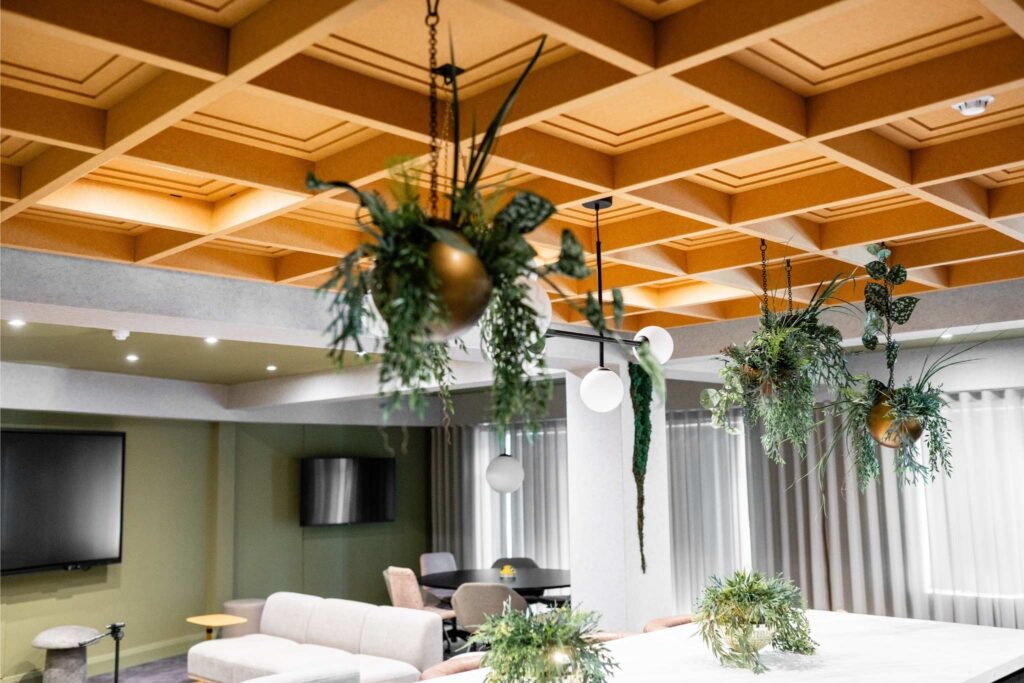
Acoustic Standards in the UK: What Designers Need to Know
When you’re designing spaces where people work, learn, or heal, acoustics shouldn’t be an afterthought; they’re central to how comfortable, calm, and productive a space feels. But the world of acoustic standards can be a bit of a maze. Different sectors are governed by various documents, each with its own targets for reverberation time, background noise, and sound insulation.
Here’s a quick guide to the key UK standards you’re most likely to come across, and what they mean in practice.

The Core Measurement Standards
Before diving into sector-specific guidance, it’s worth knowing the baseline standards that underpin everything:
- BS EN ISO 3382 – Defines how to measure room acoustic parameters, including reverberation time (RT60).
- BS EN ISO 11654 – Classifies sound absorbers by performance (Class A–E).
- BS EN ISO 354 – Laboratory method for measuring sound absorption.
- BS EN ISO 717 – Rates sound insulation between rooms and buildings
These are the “how it’s measured” documents; they don’t set targets themselves, but everything else refers back to them.

Workplaces & Offices
Unlike schools and hospitals, offices in the UK don’t have a statutory acoustic standard. Instead, they follow international best practice — and yet, creating spaces that support focus and wellbeing is still crucial. Considering that it can take over 23 minutes to refocus on a task after being distracted, it’s no surprise that noise in open-plan offices can reduce productivity by up to 66%.
Key guidance and standards include:
- BS EN ISO 22955:2021 – Acoustic Quality of Open Office Spaces
Provides guidance on reverberation control, speech intelligibility, and balancing privacy with communication. It recognises that open-plan offices require a different approach than enclosed rooms. - WELL Building Standard & BREEAM
Set performance targets for acoustics within broader sustainability and wellbeing frameworks, covering noise from building services, privacy, and how reverberation affects comfort. - CIBSE Guide A & B
Offers recommendations for background noise and building services noise in commercial spaces.
- BS EN ISO 22955:2021 – Acoustic Quality of Open Office Spaces
In practice, designers use these standards to create workplaces that support concentration, reduce distractions, and feel calm — without making them completely silent.

Schools – BB93
Education has the strictest acoustic rules, and for good reason. Poor acoustics can make learning harder, especially for younger children, those with hearing difficulties, or neurodiverse students — in a school of 1,000 pupils, around 150 may be neurodiverse. Teachers are also affected, with many reporting stress from trying to communicate effectively in noisy classrooms.
- BB93: Acoustic Design of Schools (DfE Guidance)
- Classrooms: maximum reverberation time of 0.6 seconds.
- Sports halls: maximum 2.0 seconds, reduced to 1.5 seconds for smaller spaces.
- Music rooms: controlled reverberation to support performance without losing clarity.
- Sound insulation & background noise: strict requirements to protect speech intelligibility and minimise distractions.
- BB93: Acoustic Design of Schools (DfE Guidance)
This is a statutory requirement under Building Regulations, so compliance isn’t optional. Well-designed acoustics help students concentrate, support teachers’ wellbeing, and ensure every child has the best possible chance to learn.

Healthcare – HTM 08-01
In healthcare settings, acoustics are about more than comfort — they directly affect patient recovery and staff wellbeing. Around 40% of hospital patients report being disturbed by noise at night, and excessive noise has been shown to negatively impact recovery rates. Staff performance and wellbeing are also affected, with high noise levels contributing to stress and burnout.
To address this, the UK uses HTM 08-01: Acoustics in Healthcare Premises, a standard that provides clear guidance on how to manage sound in clinical environments:
- Reverberation time: sets limits for different clinical areas, typically aiming for ≤1.0s in treatment rooms.
- Speech privacy: ensures confidentiality between consulting rooms and wards.
- Noise control: helps patients rest and recover more effectively.
Good acoustics in hospitals create calmer, less stressful environments for patients and allow staff to concentrate and work more effectively, supporting overall wellbeing.

Specialist Spaces
Performance and cultural venues need tailored acoustic design. These spaces are less about strict “compliance” and more about meeting high-quality design standards.
- BS EN 12354 – Prediction methods for building acoustics.
- ISO 23591 – Guidelines for the design of concert halls and performance spaces.
- Specialist guidance also comes from bodies like the Association of Noise Consultants (ANC).
These standards support precision design in places where sound quality is the whole experience.

While the legal requirements are strongest in schools and healthcare, every sector benefits from clear acoustic targets. Standards give designers a framework — but it’s the creative application of acoustic products and design strategies that turns guidelines into spaces that feel calm, balanced, and inspiring.
If you’re planning your next workspace or education project and want to explore acoustic solutions that meet (and often exceed) these standards, take a look at our range of products designed for both performance and aesthetics.
Want to explore acoustic solutions that are tailored to your next design project? Take a look at our full range of acoustic solutions here or give us a call on +44 (0)20 3889 9888, email us at hello@allsfar.com or fill in our contact form on our website here.
Keep In Touch
Sign up to our newsletter and find out about our latest products, new projects and showroom events.
Products
AllSfär © 2025